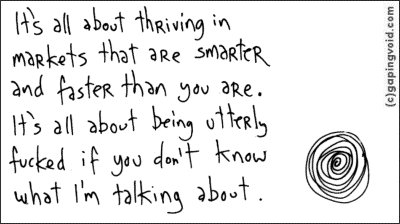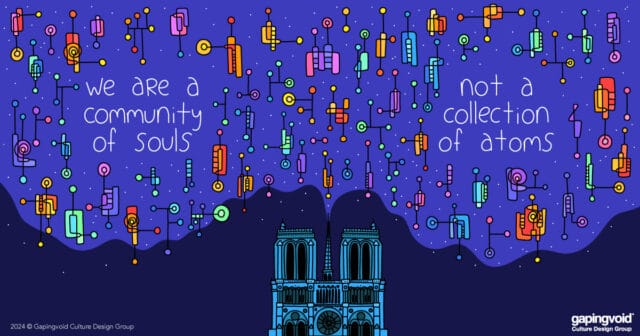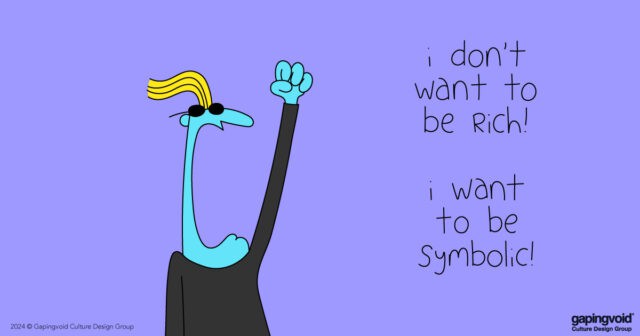
[Cartoon originally appeared in “The Hughtrain”.]
1. Sarah Blow left a nice note in the comments of yesterday’s “Cloud” post:
A cloud computing system is only as reliable as the hardware and software that it is built upon. I have a feeling people are going to get their fingers burnt a few times before the cloud becomes a permanent place of work.
It definitely has its uses though… Loving Evernote and a couple of other cloud systems. However most of them suck some what 😉 partially completed, little or no mobile interaction and no focus. They’ll learn one day.
[….]
An interesting question for your readers… Where do they see the bottleneck in cloud computing…
Ummmm…. Bottlenecks. Anybody? Please leave a comment below, Thanks.
2. And a quasi-related story. This morning I received a kind letter from a PR guy who follows me on Twitter:
Hugh,
Saw your tweets about cloud computing. Thought you might be interested in the infrastructure side of the story. For there to be a dominant player(s), there has to be network infrastructure to support them. AT&T’s announcement this morning discusses that. Here is a link to a story today on Bloomberg about the announcement.
And, here is a link to the media kit on AT&T’s site.
And so forth.
An hour later I notice on Techmeme that the same story has already hit the mainstream press. It’s always interesting watching the PR machine in action in action.
Like I told my old PR buddy, Dave Parmet, I don’t mind PR flacks sending me stories, at least from the ones who aren’t clueless.
PR people are like advertising people: Everybody hates them, until they have a business that actually needs one [Note To Self: “People hate AT&T, until they need an iPhone.” Or something like that…].
3. I’m enjoying my new adventure with Dell. Like my schtick with Microsoft, I’m doing it for a reason, which I hinted at in a blog post I wrote last year:
4. You’ve already done “efficient”. We’re living in a post-efficiency world now. We already know how to make things better, cheaper and faster than the previous generation. We already know how to squeeze our suppliers till the pips squeak. We already know how to build systems that maximize profits at every stage of the production and selling process. We’re already outsourcing our stuff to China, and so is everyone else. Been there. Done that. So where does the growth need to come from? What needs to happen, in order to save your job?
THESIS:
5. The growth will come, I believe, not by yet more increased efficiencies, but by humanification. For example, take two well-known airlines. They both perform a useful service. They both deliver value. They both cost about the same to fly to New York or Hong Kong. Both have nice Boeings and Airbuses. Both serve peanuts and drinks. Both serve “airline food”. Both use the same airports. But one airline has friendly people working for them, the other airline has surly people working for them. One airline has a sense of fun and adventure about it, one has a tired, jaded business-commuter vibe about it. Guess which one takes the human dimension of their business more seriously than the other? Guess which one still will be around in twenty years? Guess which one will lose billions of dollars worth of shareholder value over the next twenty years? What parallels do you see in your own industry? In your own company?
It’s all about the “Humanification”, Folks.
How does a big company [like Dell, like Microsoft etc etc] “humanify” themselves? How do they “de-commodify” themselves? It’s a subject that never fails to fascinate me. That’s why I do what I do. Rock on.
[UPDATE:} The uber-intelligent Lee Byant from Headshift left a great comment below:
Hi Hugh,
I agree that the twin challenges of de-commoditisation and humanisation are part of the key to companies like this developing the kind of new relationships we all want to see.
You have tried the blue monster thing, which is a kind of internal advertising campaign, to galvanise people inside large companies. I think we need to complement this with a number of other techniques to humanise the organisation and take internal brand engagement to a new level if we are to move forward.
I wrote a longish post about this recently based on a talk I gave at Reboot: http://www.headshift.com/blog/2008/07/free-the-battery-humans.php



